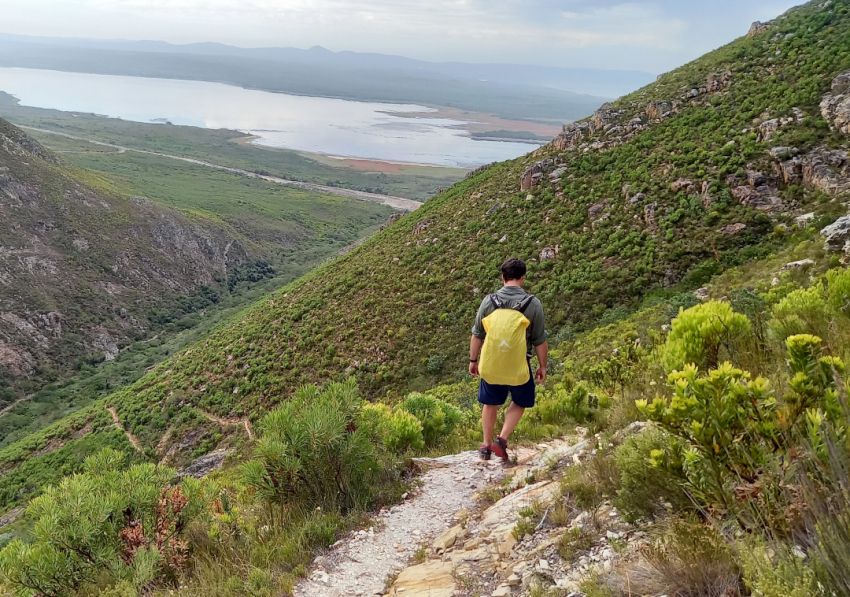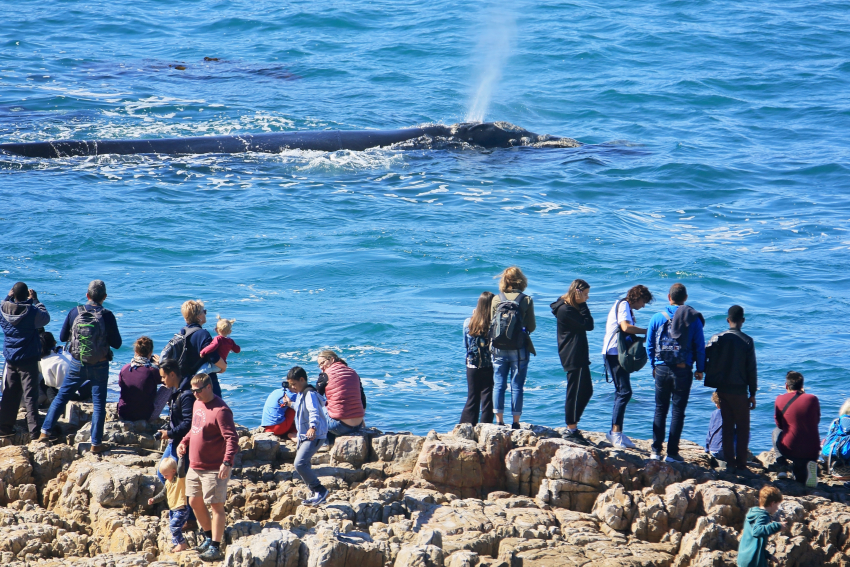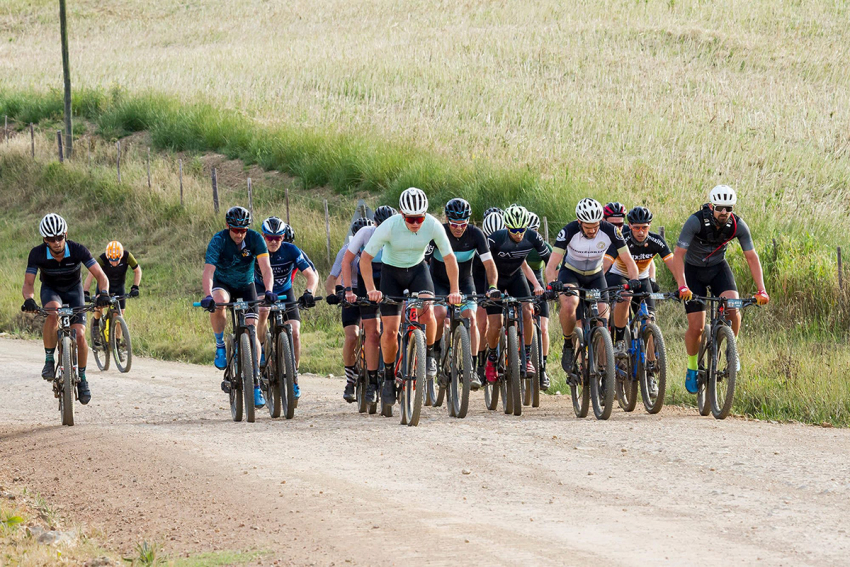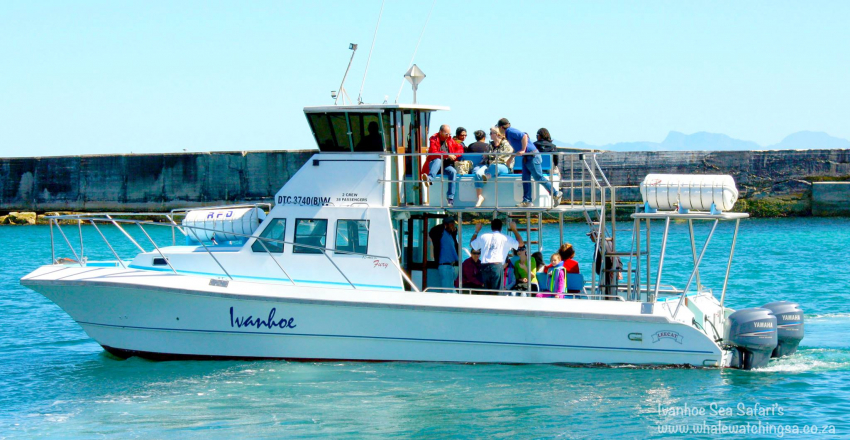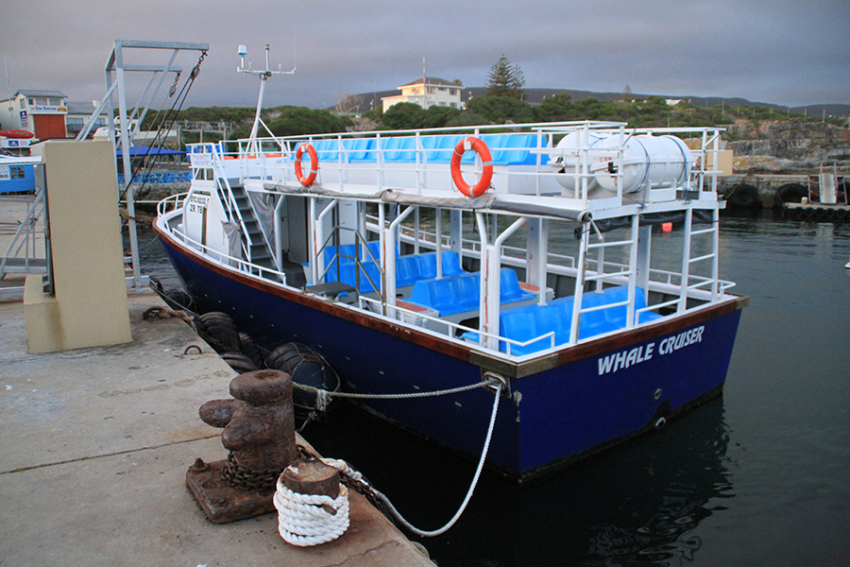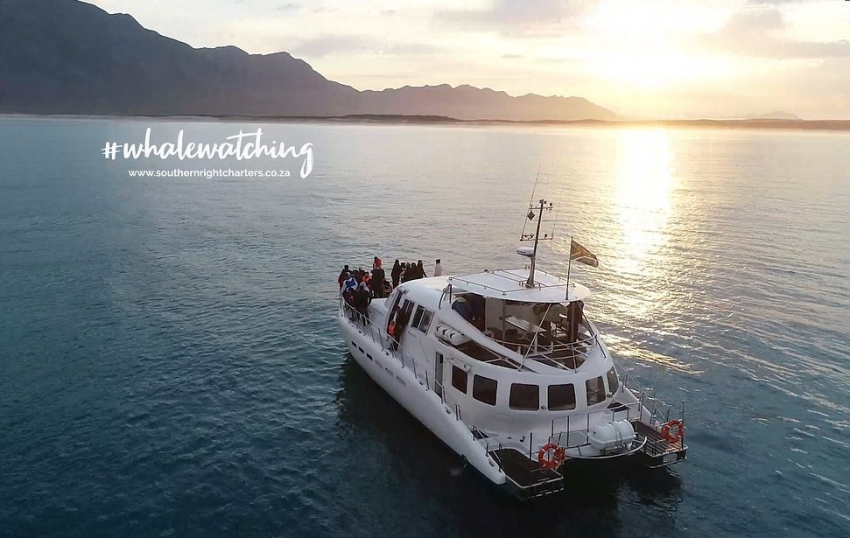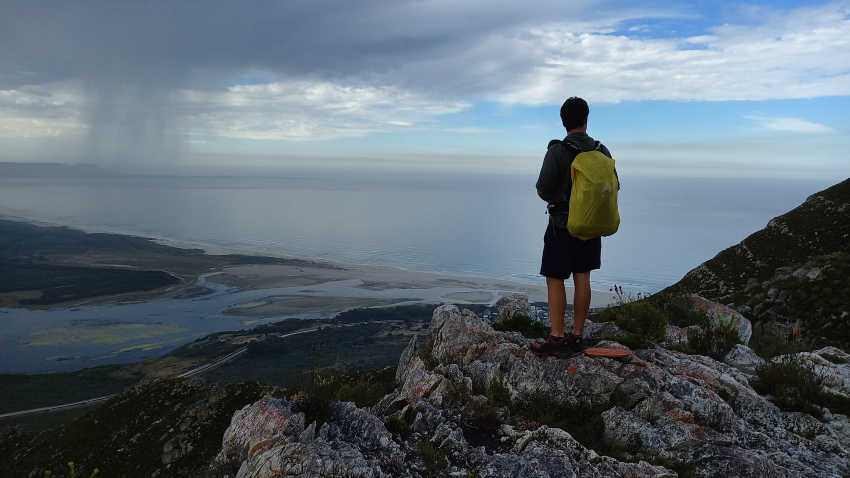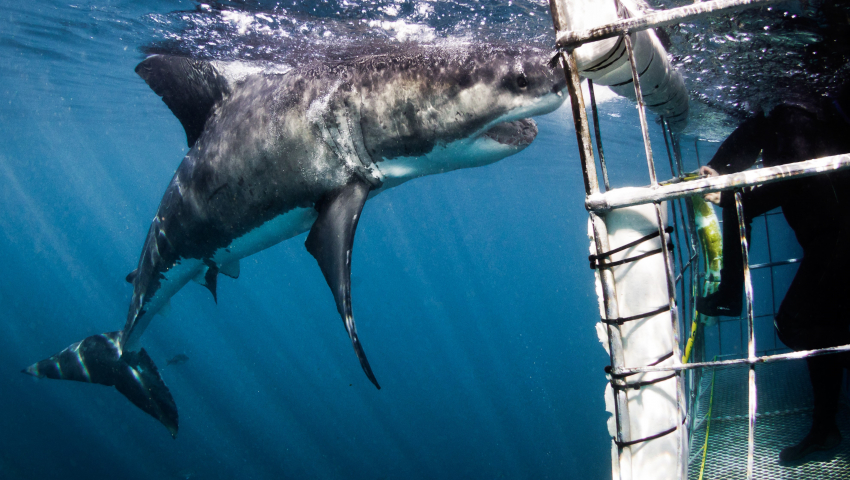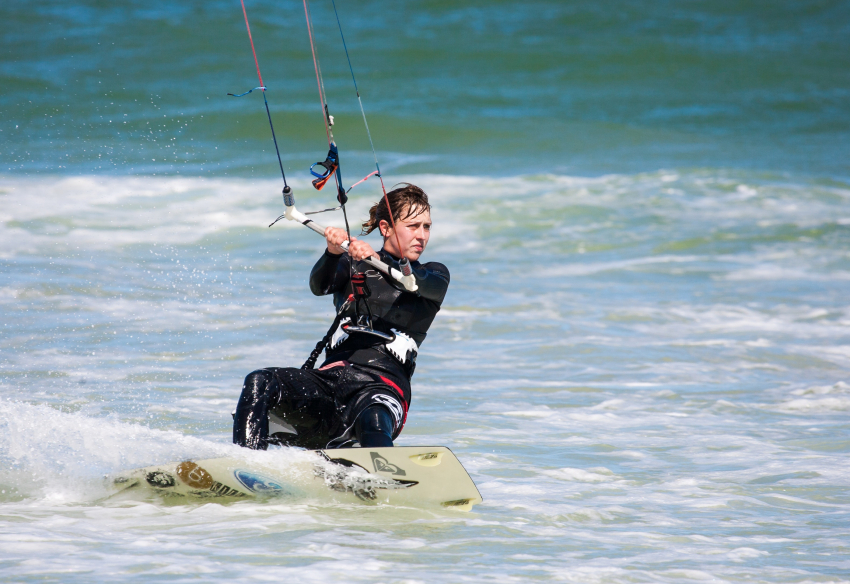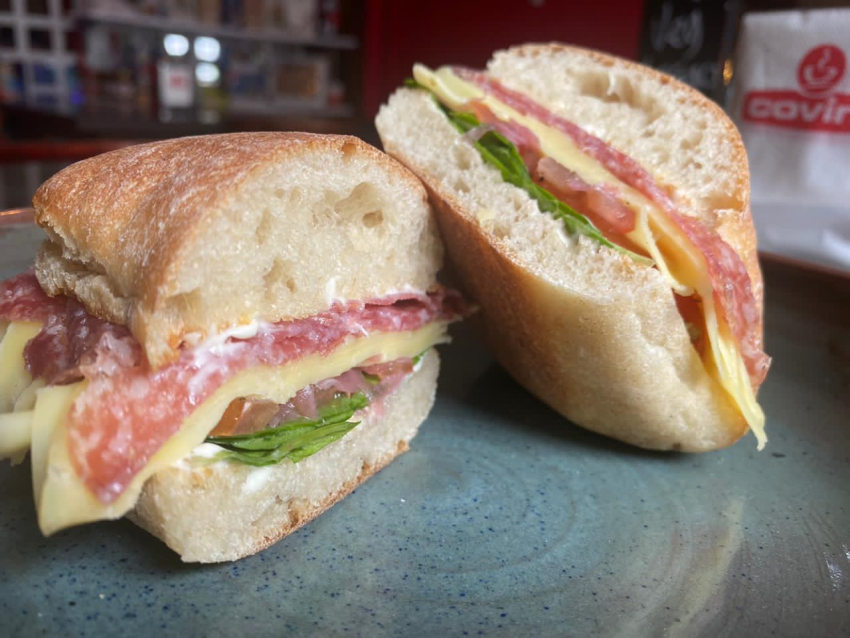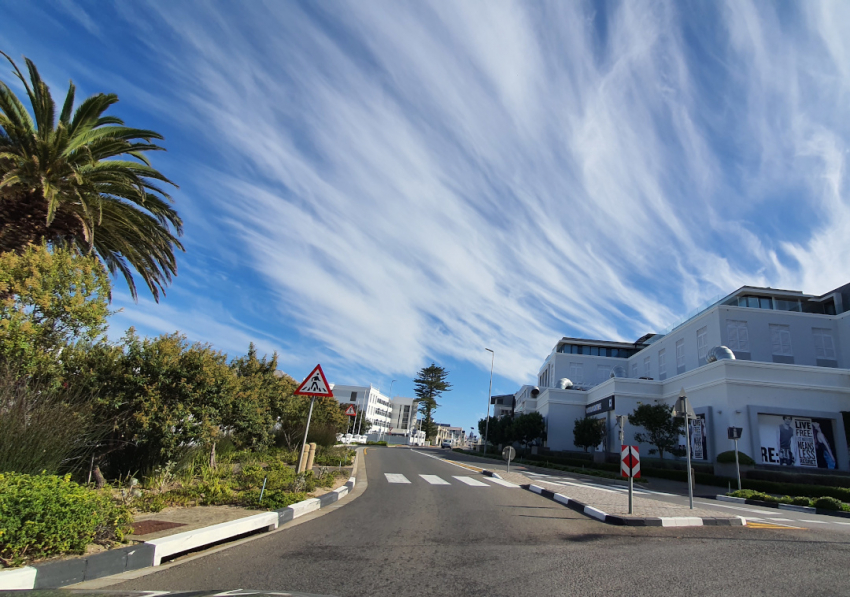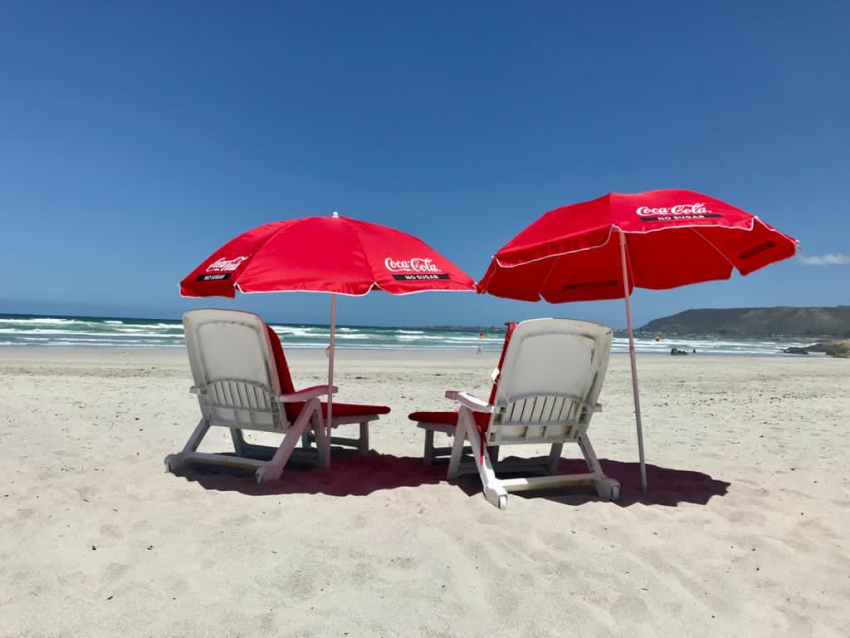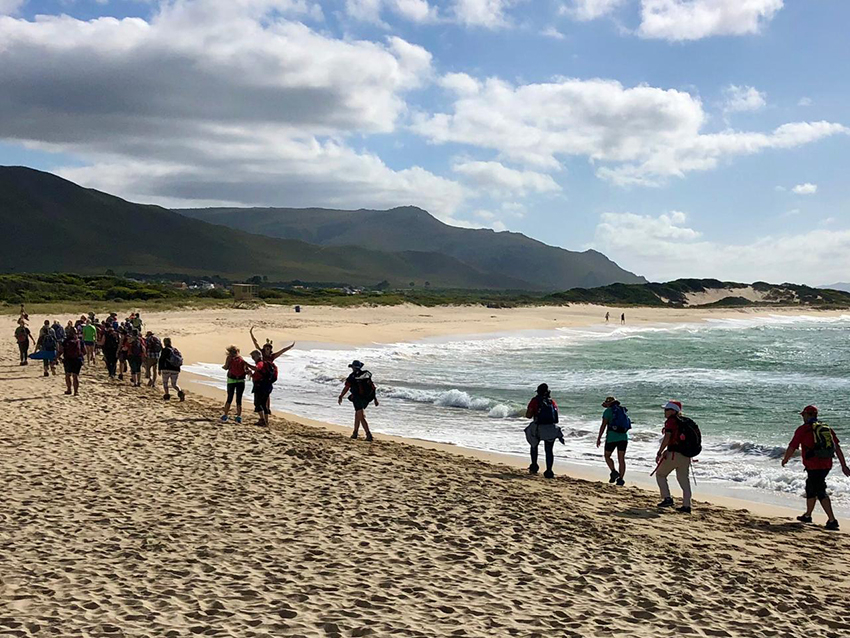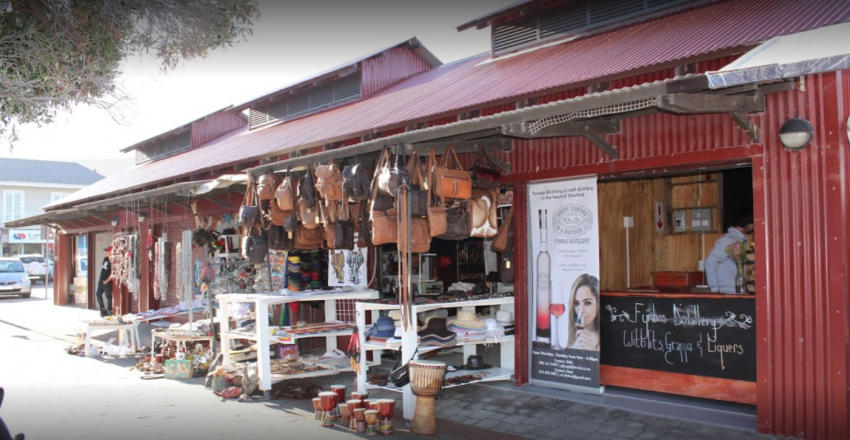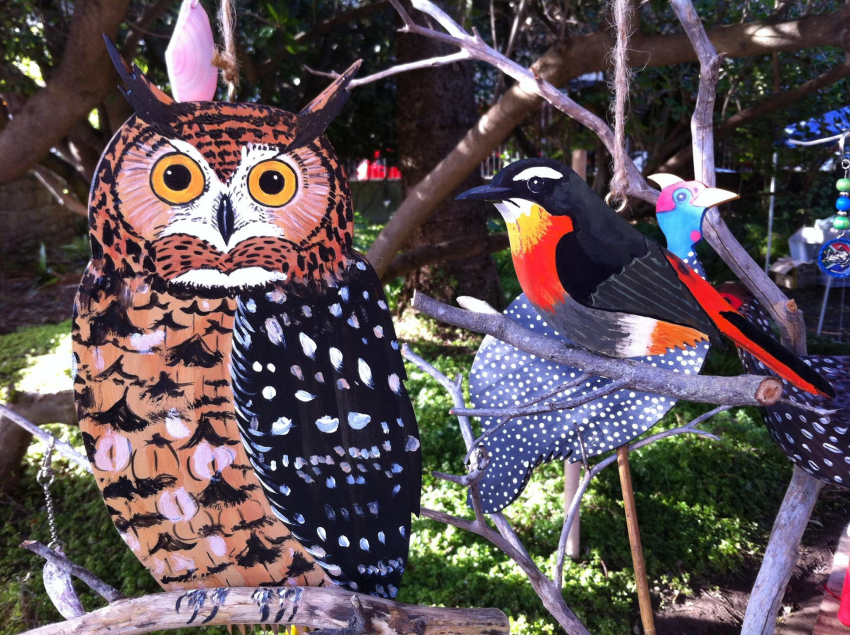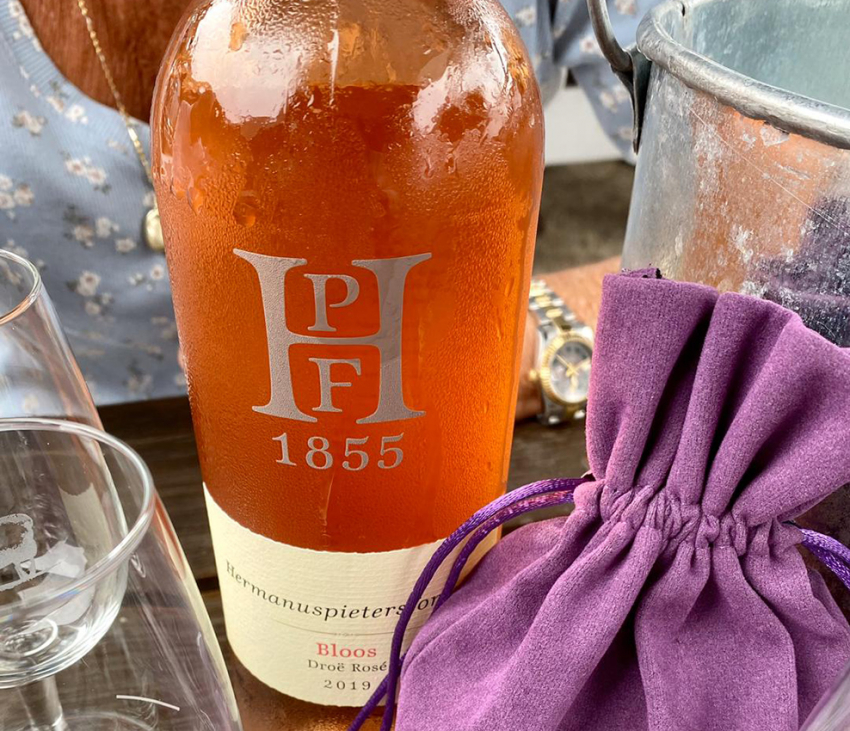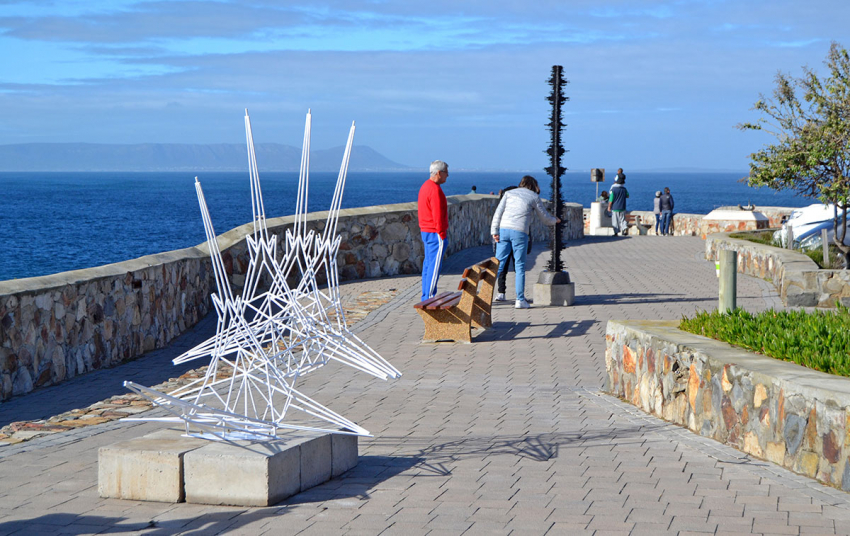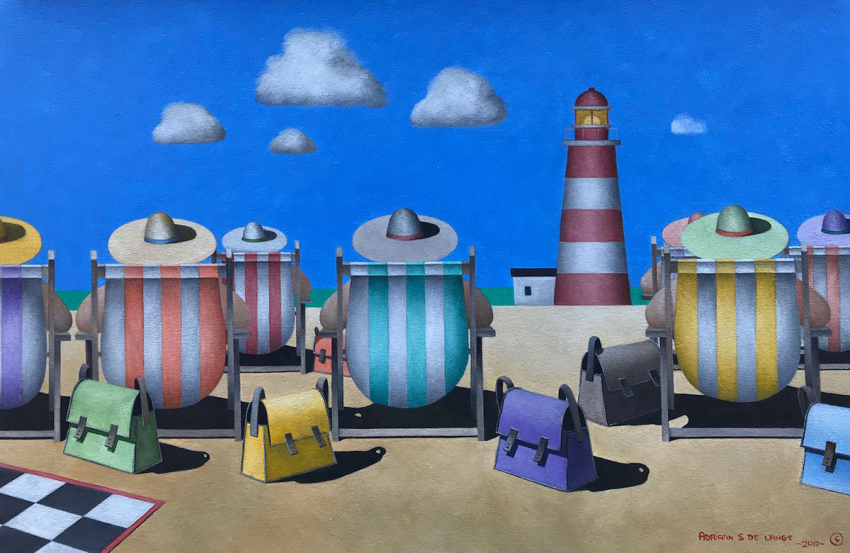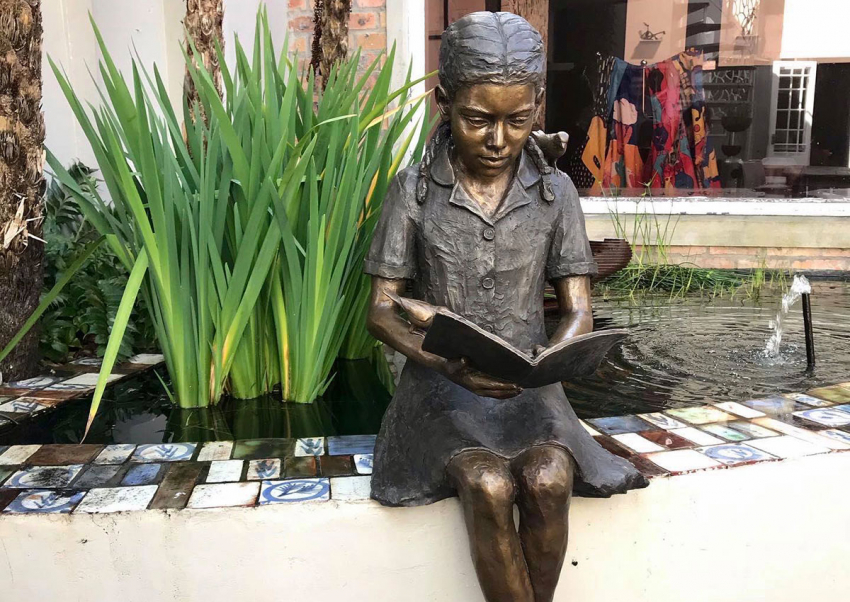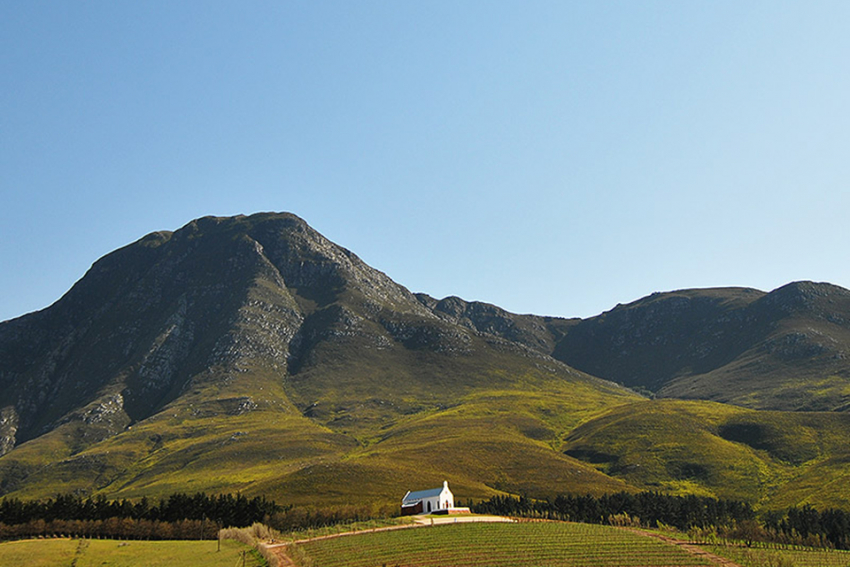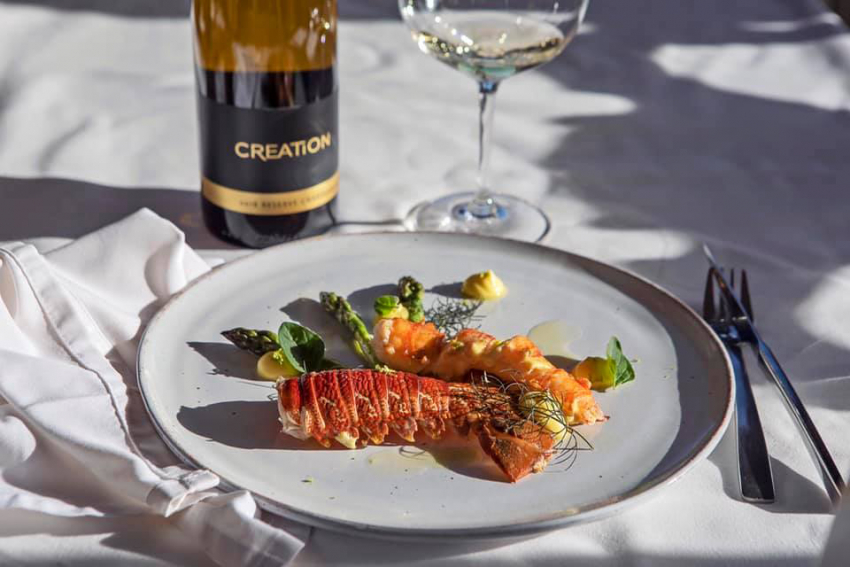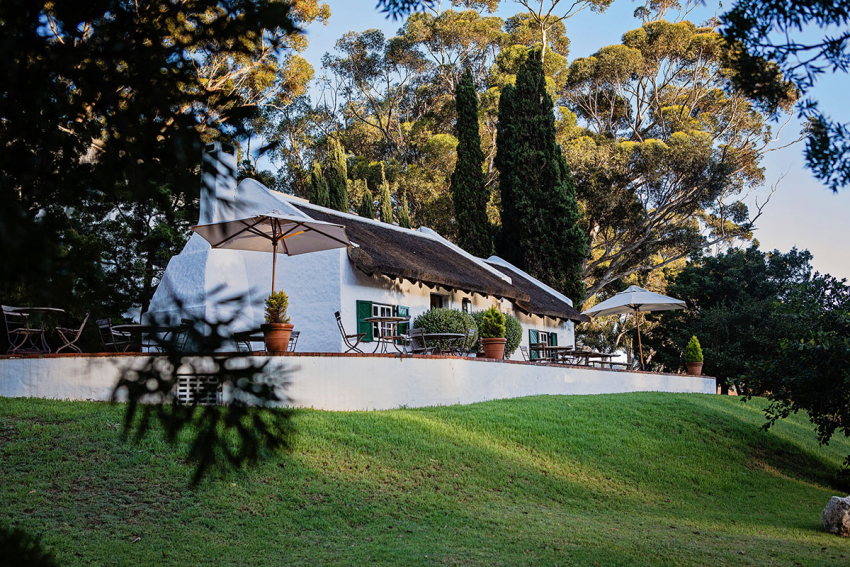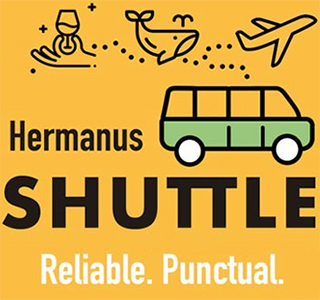Shortly before the 2006 whale season, I walked into Photo Holler and talked to Ingo Schirmer about various Hermanus matters, among them the dangerous coastline on the “Champagne Mile” where three drownings have taken place over the last three years resulting in the death of four people. We were both concerned that the powers that be had done nothing to warn residents and tourists using the cliff path for whale watching, of the dangers of that treacherous stretch of water. But, said Ingo, he heard that the ladies of The Sharklady were doing something about it.
That very evening I set off down Marine Drive to the headquarters of The Sharklady. There are actually two ladies running the business but the singular name was coined in a pub. It suited them so they decided to adopt it and it has now become a well-known name in the world of shark viewing and cage diving. The two are Kim Maclean and Terry McCarthy who, when I called, were busy putting the finishing touches to a large notice board to be erected on the cliff path to warn visitors of potential dangers. They showed me the life saving equipment which will be ready for the coming whale festival – life buoys mounted outside their shop which is a few metres from the place where two tourists drowned in 2005, and a huge loud hailer to broadcast warnings and direct people who are in trouble. After talking to Kim, I alerted the local press to spread the word of warning for our visitors. A few days later, Kim agreed to tell her story for Hermanus Stories III.
Historical house
The house from where The Sharklady operates, was once the home of the erstwhile famous fisherman of Hermanus, Henry Minnaar, whose story is told in Hermanus Stories I. Henry spent most of his days at sea and manned the telephone exchange at night. Today, The Sharklady, who is as passionate about the sea, lives in and works from this historic old home.
Childhood
Kim Maclean was born and raised in Sea Point, Cape Town. She came from a marine orientated family whose weekends were spent on the beaches and sailing yachts around Cape Town. Much of her young life was concentrated on the beaches of ThreeAnchorBay, Sea Point and CampsBay. There was no doubt from a young age that Kim was destined to work at or on sea and with sea creatures. She dreamed of being a dolphin trainer. Her mother often went ballistic when Kim was swimming miles out to sea while the other children played in the shallow rock pools.
Even in the 1960s, there were crayfish poachers around. While snorkelling at the beach one day, Kim found a sack of crayfish, and knowing how her parents loved it, she dragged the sack all the way across the main road to their flat. The tar road ripped a hole in the sack and as she struggled along, crayfish were dropping out one by one. When she arrived home, her parents phoned the police as they realised it was a poacher’s haul, while she only wanted to please them but found she was not popular.
Department of Sea Fisheries
Kim matriculated at Cape TownHigh School in 1978. The following years she worked and studied at the Department of Sea Fisheries, Research Institute as she only wanted to work in marine circles. She worked in laboratories and factories as far afield as the west coast, but from day one, Kim pleaded with her bosses to let her go to sea but the department had a policy that females were not allowed to go to sea. She persisted until finally the department sent two of them on a hake tracing study.
They did so well at sea and kept up with their male colleagues that from that day on, Kim was considered part of the teams assigned to work at sea. She went on several trips to the Antarctic and was chosen to go to MarionIsland on the maiden voyage of Sea Fisheries’ new boat, The Afrikaner.
After six years of service with Sea Fisheries, where she qualified as a technical assistant in oceanography, Kim joined Dr Leonard Compagno at the South African Museum in Cape Town, assisting him voluntarily in research on great white sharks. This was another dream come true, as she was always passionate about the existence of sharks. For a little girl it was strange that her bedroom walls were adorned with large pictures of sharks and dolphins instead of pop idols and film stars.
The research work had a life-changing effect on her future plans – working on a tagging programme of the great whites gave her new insight and understanding of these giant predators in their natural environment. She spent several months on DyerIsland, observing natural predations of fur seals.
When the new Two Oceans Aquarium on Cape Town’s Waterfront was in its planning stage, Kim was chosen out of 350 other female applicants as an aquarist and collection diver. At this stage she had to do the difficult scientific class IV diving course. She was stationed in Struisbaai where they set up portapools on the jetty and went out in rubber ducks to dive for all the species needed. These were put in the portapools and transported to the holding tanks in Cape Town, even before the aquarium building was completed.
Because of her love of sharks, she worked in the group that caught the ragged tooth sharks. When they were brought back, they had to be settled in the tanks. Then an organisation known as AfriOceans with Lesley Roché worked for the release of species kept in an aquarium for a long time. Kim loved this as she was not happy about the animals being caged in, although it was necessary for education. The sharks that were in the aquarium for eleven years, were returned to the sea. To Kim it was the most emotional experience in her life to assist the tagging of and release of a shark which she was responsible for putting in the aquarium years back.
During this time, Kim became the best qualified cage diving pioneer in South Africa, by qualifying as skipper, rescue diver, level 3 first aid, as radio operator, oxygen provider and scientific class IV diver, safety at sea and life raft proficiency as well as fire fighting. Kim also qualified as a Western Cape tourist guide and specialist underwater guide but her career really opened up unexpectedly in 1992.
Early beginnings of cage diving
One day in 1992, four Italian tourists asked Kim to take them out on a boat to see the great whites. She reluctantly took them out in a small ski boat to DyerIsland and did not expect to attract too many sharks as it was winter. Within five minutes of being in the water and putting out her buoy, the sharks were swimming next to the boat which really excited her tourists. That started the ball rolling and soon Kim’s business started growing.
Kim and Terry McCarthy had known each other since school days and when her great white diving started to grow, Terry agreed to come in as partner to do the financial side of the business. One day in 1993 Kim took Terry to the airport and they saw the Sunday Times with a life-size picture of herself in her orange wind breaker on the front page captioned: “The Woman who loves Sharks”. It was a big article and from that day all hell broke loose. People flew in from KwaZulu-Natal and Johannesburg and came from all over South Africa to see her sharks.
Kim soon had to cater for a wide international clientele while also still working at the new Two Oceans Aquarium, but after eight months she decided to switch to white shark tours and cage diving full-time. Kim felt a need to educate people as she believed that the general consensus was that the only good shark is a dead shark, as well as sharks being called man-eating monsters, which Kim had come to know that was not the truth. Her boat and staff grew with her business and to date she is the only hands-on female operator in a fast growing male dominated industry . She is also one of a few woman in the world working with great white sharks on a commercial level.
A much maligned animal
Owing to massive negative media publicity over the years especially generated by the box-office success of ‘Jaws’ based on a book by Robert Benchley, sharks have become one of the most maligned, misunderstood, even hated animals on our fragile planet. They have been pursued, hunted and indiscriminately slaughtered to the point where many species are endangered. The relatively few shark attacks on humans encroaching on their habitat also cause knee-jerk reaction and hysteria.
If we can dispel some of the hype, myth, and fear which surround these magnificent animals and through our commitment we only introduce some element of objective perspective to the people we come into contact with, then we have at least made some contribution to maintaining the natural balance in at least one ecosystem on our communal home, Earth.
Kim’s new goal, which is part of her vision, is to build an education centre for marine life along our coastline and to educate our youth in protecting, conserving and understanding all marine species. She continually assists Marine and Coastal Management (the new name for Sea Fisheries) in looking after the marine interests of the Hermanus, Gansbaai and Kleinbaai areas.
As millions of sharks are killed every year in brutal ways, there is a need to educate people from around the globe that sharks have a purpose in our oceans especially the great white which is the apex predator and top of the food chain. Most people today know the great white from the harmful ‘Jaws’ movie as mentioned. To date Kim and other operators are still taking thousands of tourists to see this animal in its natural environment and on returning from a day out at sea, clients have a totally new found and unexpected respect for the great white shark. Kim herself admits that she has been privileged to work in such a close proximity of this apex predator and hopes to carry on for many years in education, conserving and protecting sharks and the marine life in the waters surrounding our coastline.
“The Sharklady” name was coined in a pub
One evening, about seven years ago, they were in a Gansbaai pub and someone wanted to know: “Who is this lady?” and the barman replied: “She is the Sharklady”, and the name stuck to this day. It is a catchy name and suits Kim to a T.
There are at present eight cage diving operators from the Kleinbaai harbour, one in MosselBay and two in False Bay. Kim was the only local operator for at least three years before the others followed her example. The fast growing industry combined with a few operators, defies competition and boats are usually packed in season.
Drownings at the coast
The flat rock right in front of The Sharklady is as treacherous as Hardlopersbank (Runners bank) in Voëlklip where fishermen often have to run for their lives when the breakers roar in. Kim and Terry witnessed an incident when a woman drowned some years ago, and were present last year at the tragic drowning of two tourists. A woman was obviously in trouble in the water and Kim was ready to shed her shoes and jacket and dive in, but realised it would be the end of her as the water was so rough that no one would dare to go in. She and Terry were running up and down, shouting at the people in peril, but it seems that the lady disappeared at once and died. A gentleman nearby, presumably her husband, plunged in to the raging waters in a valiant but vain attempt to rescue the woman but a huge whale surfaced, flapping its tail so close to him that he disappeared under the waves and drowned but he could possibly have died of a heart attack first. The NSIR boat came, but did not see him in the waves and sped past him and on to the old harbour. Both bodies were eventually recovered.
After the tragedy of both that lady, the young boy before her and now the two tourists, a huge outcry accompanied by letters to the press ensued. Something had to be done. Kim already had life saving equipment and installed it on the wall outside her shop. They have a loud hailer to warn and instruct people in trouble. As it is, some people ignore the warning sign and still go near the water on rough days. Recently Kim had to go right up to a man with his small son, on the rocks to warn them. A minute after she dragged them away, a gigantic wave hit the place where they stood and they realised she had saved them. But people, especially visitors, are ignorant of the power of the sea and ignore warnings, so accidental drownings will never be eliminated.
Shooting the sharks (with cameras, not guns)
In September 2006, Kim received an e-mail from a producer at the Hollywood studios of the American Survivor series. She thought it was a joke until one night late, she received a call from the same producer, who explained that he had come across her website, did some homework on her character and that he wanted to fly her over to Los Angeles, all expenses paid, as he wanted to do a ten-part series with The Sharklady.
Kim thought it too good to be true but the reality is that the producer intended to set up a travelling studio in Hermanus and Gansbaai to film the local activities. But first they will be filming the Sharklady in ten different parts of the world, diving with different shark species and ending off in South Africa, diving with the great white.
May The Sharklady and her adventure tours be on our shores for a long time to come. I salute her courage!
Article extracted from SJ du Toit – Whale Capital Chronicles III, Page 280.
Should you wish to use any of her stories please contact SJ du Toit directly.

